Accounting Issues and Tax Clarification: Response Letter
VerifiedAdded on 2021/06/18
|5
|1497
|30
Report
AI Summary
This report presents a detailed response letter from Ebony & Associates to Martin Muller, Managing Director of Muppets Ltd, addressing specific accounting concerns. The letter clarifies issues related to asset valuation, particularly of non-current assets, and explains the application of AASB standards (AASB 116, AASB 5, AASB 1041) concerning tangible and intangible assets, depreciation, and impairment. It details the use of the historical cost model for asset valuation, the impact of depreciation on asset values, and the process of revaluation. Furthermore, the letter addresses tax-related questions, explaining discrepancies between actual tax paid and taxable figures, including factors like company losses, tax agreements, withholding taxes, and offshore tax treaties. The response emphasizes the importance of disclosure and reliable measurement of these items in financial reporting, providing a comprehensive overview of accounting principles and tax implications relevant to the company's financial statements.
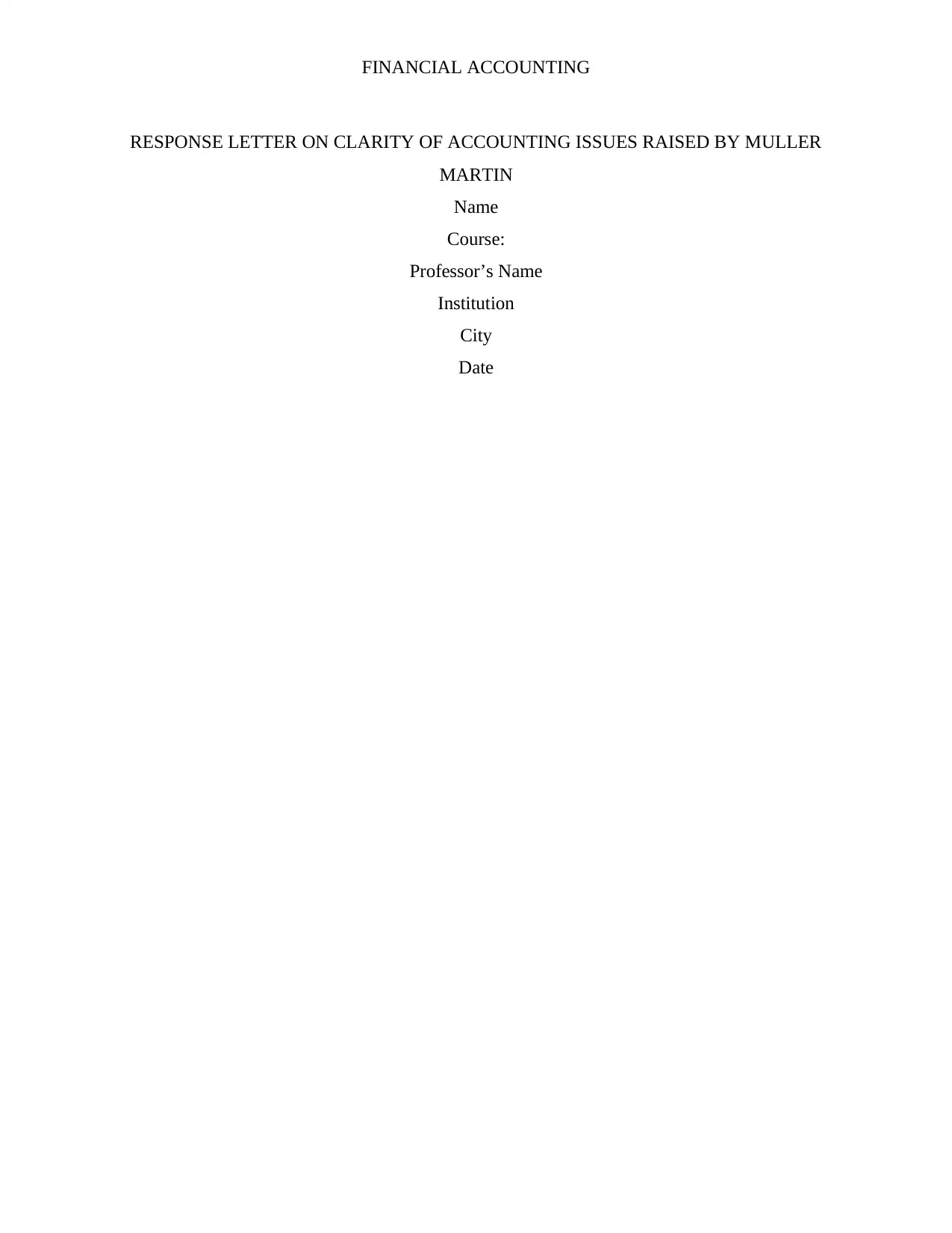
FINANCIAL ACCOUNTING
RESPONSE LETTER ON CLARITY OF ACCOUNTING ISSUES RAISED BY MULLER
MARTIN
Name
Course:
Professor’s Name
Institution
City
Date
RESPONSE LETTER ON CLARITY OF ACCOUNTING ISSUES RAISED BY MULLER
MARTIN
Name
Course:
Professor’s Name
Institution
City
Date
Paraphrase This Document
Need a fresh take? Get an instant paraphrase of this document with our AI Paraphraser
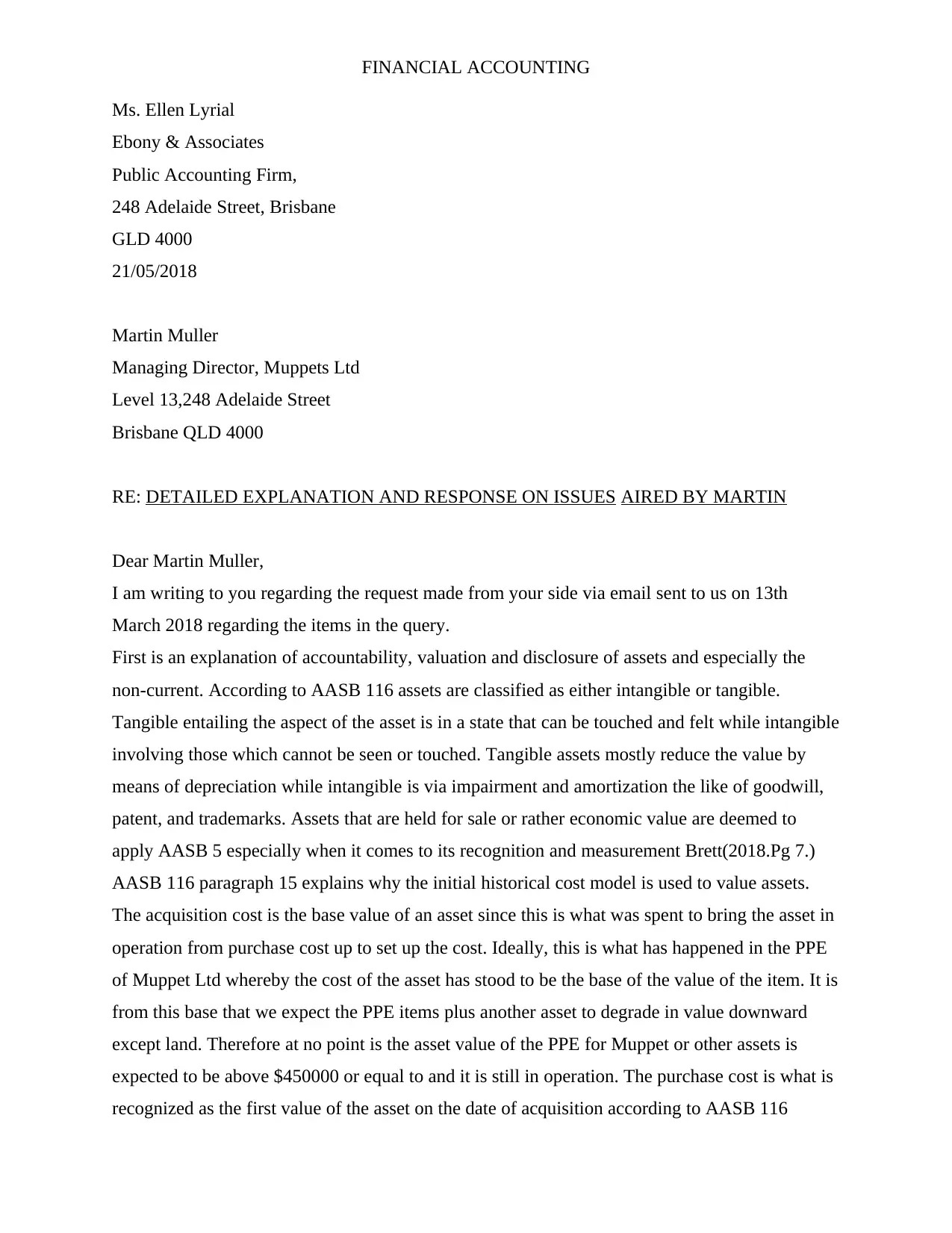
FINANCIAL ACCOUNTING
Ms. Ellen Lyrial
Ebony & Associates
Public Accounting Firm,
248 Adelaide Street, Brisbane
GLD 4000
21/05/2018
Martin Muller
Managing Director, Muppets Ltd
Level 13,248 Adelaide Street
Brisbane QLD 4000
RE: DETAILED EXPLANATION AND RESPONSE ON ISSUES AIRED BY MARTIN
Dear Martin Muller,
I am writing to you regarding the request made from your side via email sent to us on 13th
March 2018 regarding the items in the query.
First is an explanation of accountability, valuation and disclosure of assets and especially the
non-current. According to AASB 116 assets are classified as either intangible or tangible.
Tangible entailing the aspect of the asset is in a state that can be touched and felt while intangible
involving those which cannot be seen or touched. Tangible assets mostly reduce the value by
means of depreciation while intangible is via impairment and amortization the like of goodwill,
patent, and trademarks. Assets that are held for sale or rather economic value are deemed to
apply AASB 5 especially when it comes to its recognition and measurement Brett(2018.Pg 7.)
AASB 116 paragraph 15 explains why the initial historical cost model is used to value assets.
The acquisition cost is the base value of an asset since this is what was spent to bring the asset in
operation from purchase cost up to set up the cost. Ideally, this is what has happened in the PPE
of Muppet Ltd whereby the cost of the asset has stood to be the base of the value of the item. It is
from this base that we expect the PPE items plus another asset to degrade in value downward
except land. Therefore at no point is the asset value of the PPE for Muppet or other assets is
expected to be above $450000 or equal to and it is still in operation. The purchase cost is what is
recognized as the first value of the asset on the date of acquisition according to AASB 116
Ms. Ellen Lyrial
Ebony & Associates
Public Accounting Firm,
248 Adelaide Street, Brisbane
GLD 4000
21/05/2018
Martin Muller
Managing Director, Muppets Ltd
Level 13,248 Adelaide Street
Brisbane QLD 4000
RE: DETAILED EXPLANATION AND RESPONSE ON ISSUES AIRED BY MARTIN
Dear Martin Muller,
I am writing to you regarding the request made from your side via email sent to us on 13th
March 2018 regarding the items in the query.
First is an explanation of accountability, valuation and disclosure of assets and especially the
non-current. According to AASB 116 assets are classified as either intangible or tangible.
Tangible entailing the aspect of the asset is in a state that can be touched and felt while intangible
involving those which cannot be seen or touched. Tangible assets mostly reduce the value by
means of depreciation while intangible is via impairment and amortization the like of goodwill,
patent, and trademarks. Assets that are held for sale or rather economic value are deemed to
apply AASB 5 especially when it comes to its recognition and measurement Brett(2018.Pg 7.)
AASB 116 paragraph 15 explains why the initial historical cost model is used to value assets.
The acquisition cost is the base value of an asset since this is what was spent to bring the asset in
operation from purchase cost up to set up the cost. Ideally, this is what has happened in the PPE
of Muppet Ltd whereby the cost of the asset has stood to be the base of the value of the item. It is
from this base that we expect the PPE items plus another asset to degrade in value downward
except land. Therefore at no point is the asset value of the PPE for Muppet or other assets is
expected to be above $450000 or equal to and it is still in operation. The purchase cost is what is
recognized as the first value of the asset on the date of acquisition according to AASB 116
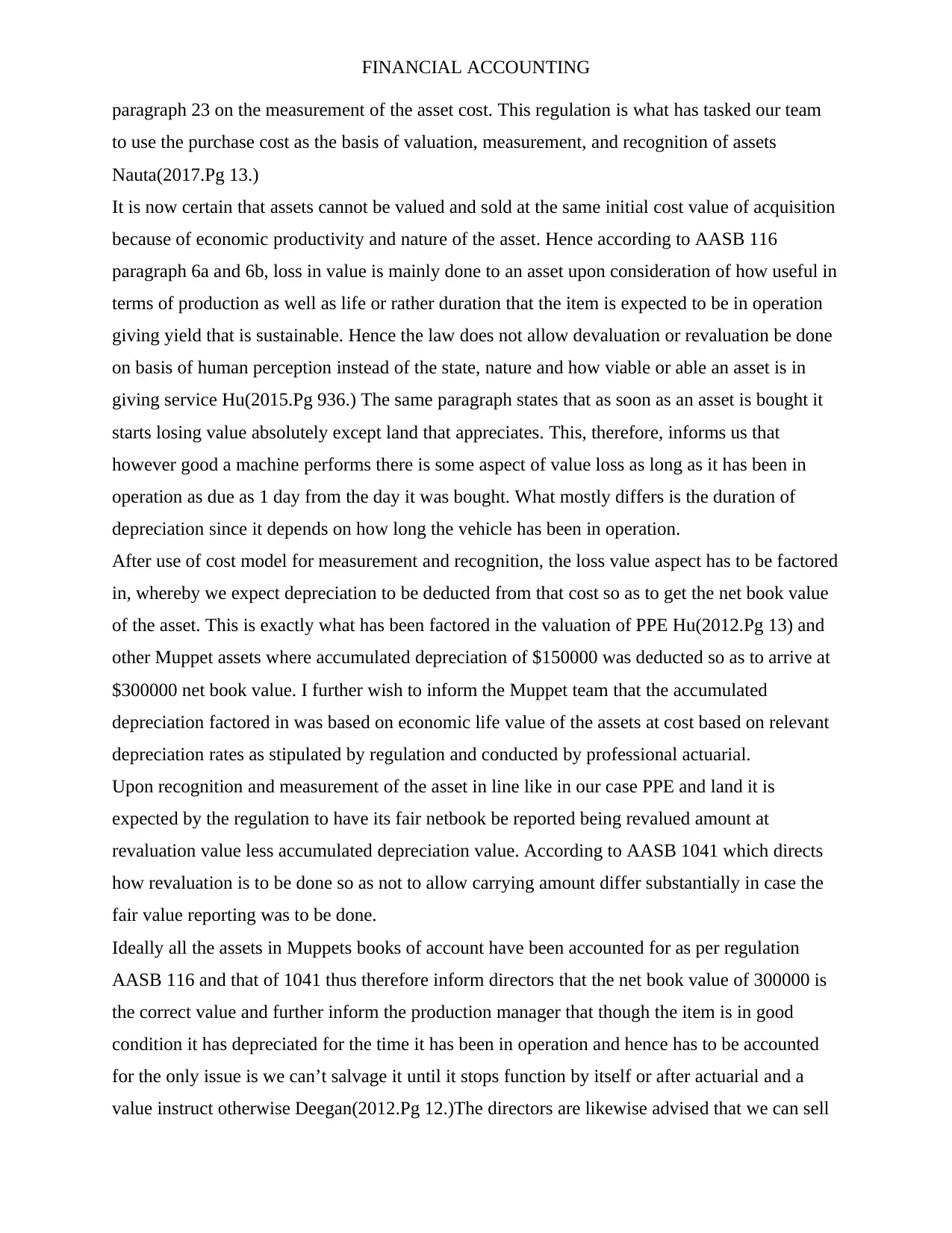
FINANCIAL ACCOUNTING
paragraph 23 on the measurement of the asset cost. This regulation is what has tasked our team
to use the purchase cost as the basis of valuation, measurement, and recognition of assets
Nauta(2017.Pg 13.)
It is now certain that assets cannot be valued and sold at the same initial cost value of acquisition
because of economic productivity and nature of the asset. Hence according to AASB 116
paragraph 6a and 6b, loss in value is mainly done to an asset upon consideration of how useful in
terms of production as well as life or rather duration that the item is expected to be in operation
giving yield that is sustainable. Hence the law does not allow devaluation or revaluation be done
on basis of human perception instead of the state, nature and how viable or able an asset is in
giving service Hu(2015.Pg 936.) The same paragraph states that as soon as an asset is bought it
starts losing value absolutely except land that appreciates. This, therefore, informs us that
however good a machine performs there is some aspect of value loss as long as it has been in
operation as due as 1 day from the day it was bought. What mostly differs is the duration of
depreciation since it depends on how long the vehicle has been in operation.
After use of cost model for measurement and recognition, the loss value aspect has to be factored
in, whereby we expect depreciation to be deducted from that cost so as to get the net book value
of the asset. This is exactly what has been factored in the valuation of PPE Hu(2012.Pg 13) and
other Muppet assets where accumulated depreciation of $150000 was deducted so as to arrive at
$300000 net book value. I further wish to inform the Muppet team that the accumulated
depreciation factored in was based on economic life value of the assets at cost based on relevant
depreciation rates as stipulated by regulation and conducted by professional actuarial.
Upon recognition and measurement of the asset in line like in our case PPE and land it is
expected by the regulation to have its fair netbook be reported being revalued amount at
revaluation value less accumulated depreciation value. According to AASB 1041 which directs
how revaluation is to be done so as not to allow carrying amount differ substantially in case the
fair value reporting was to be done.
Ideally all the assets in Muppets books of account have been accounted for as per regulation
AASB 116 and that of 1041 thus therefore inform directors that the net book value of 300000 is
the correct value and further inform the production manager that though the item is in good
condition it has depreciated for the time it has been in operation and hence has to be accounted
for the only issue is we can’t salvage it until it stops function by itself or after actuarial and a
value instruct otherwise Deegan(2012.Pg 12.)The directors are likewise advised that we can sell
paragraph 23 on the measurement of the asset cost. This regulation is what has tasked our team
to use the purchase cost as the basis of valuation, measurement, and recognition of assets
Nauta(2017.Pg 13.)
It is now certain that assets cannot be valued and sold at the same initial cost value of acquisition
because of economic productivity and nature of the asset. Hence according to AASB 116
paragraph 6a and 6b, loss in value is mainly done to an asset upon consideration of how useful in
terms of production as well as life or rather duration that the item is expected to be in operation
giving yield that is sustainable. Hence the law does not allow devaluation or revaluation be done
on basis of human perception instead of the state, nature and how viable or able an asset is in
giving service Hu(2015.Pg 936.) The same paragraph states that as soon as an asset is bought it
starts losing value absolutely except land that appreciates. This, therefore, informs us that
however good a machine performs there is some aspect of value loss as long as it has been in
operation as due as 1 day from the day it was bought. What mostly differs is the duration of
depreciation since it depends on how long the vehicle has been in operation.
After use of cost model for measurement and recognition, the loss value aspect has to be factored
in, whereby we expect depreciation to be deducted from that cost so as to get the net book value
of the asset. This is exactly what has been factored in the valuation of PPE Hu(2012.Pg 13) and
other Muppet assets where accumulated depreciation of $150000 was deducted so as to arrive at
$300000 net book value. I further wish to inform the Muppet team that the accumulated
depreciation factored in was based on economic life value of the assets at cost based on relevant
depreciation rates as stipulated by regulation and conducted by professional actuarial.
Upon recognition and measurement of the asset in line like in our case PPE and land it is
expected by the regulation to have its fair netbook be reported being revalued amount at
revaluation value less accumulated depreciation value. According to AASB 1041 which directs
how revaluation is to be done so as not to allow carrying amount differ substantially in case the
fair value reporting was to be done.
Ideally all the assets in Muppets books of account have been accounted for as per regulation
AASB 116 and that of 1041 thus therefore inform directors that the net book value of 300000 is
the correct value and further inform the production manager that though the item is in good
condition it has depreciated for the time it has been in operation and hence has to be accounted
for the only issue is we can’t salvage it until it stops function by itself or after actuarial and a
value instruct otherwise Deegan(2012.Pg 12.)The directors are likewise advised that we can sell
⊘ This is a preview!⊘
Do you want full access?
Subscribe today to unlock all pages.

Trusted by 1+ million students worldwide
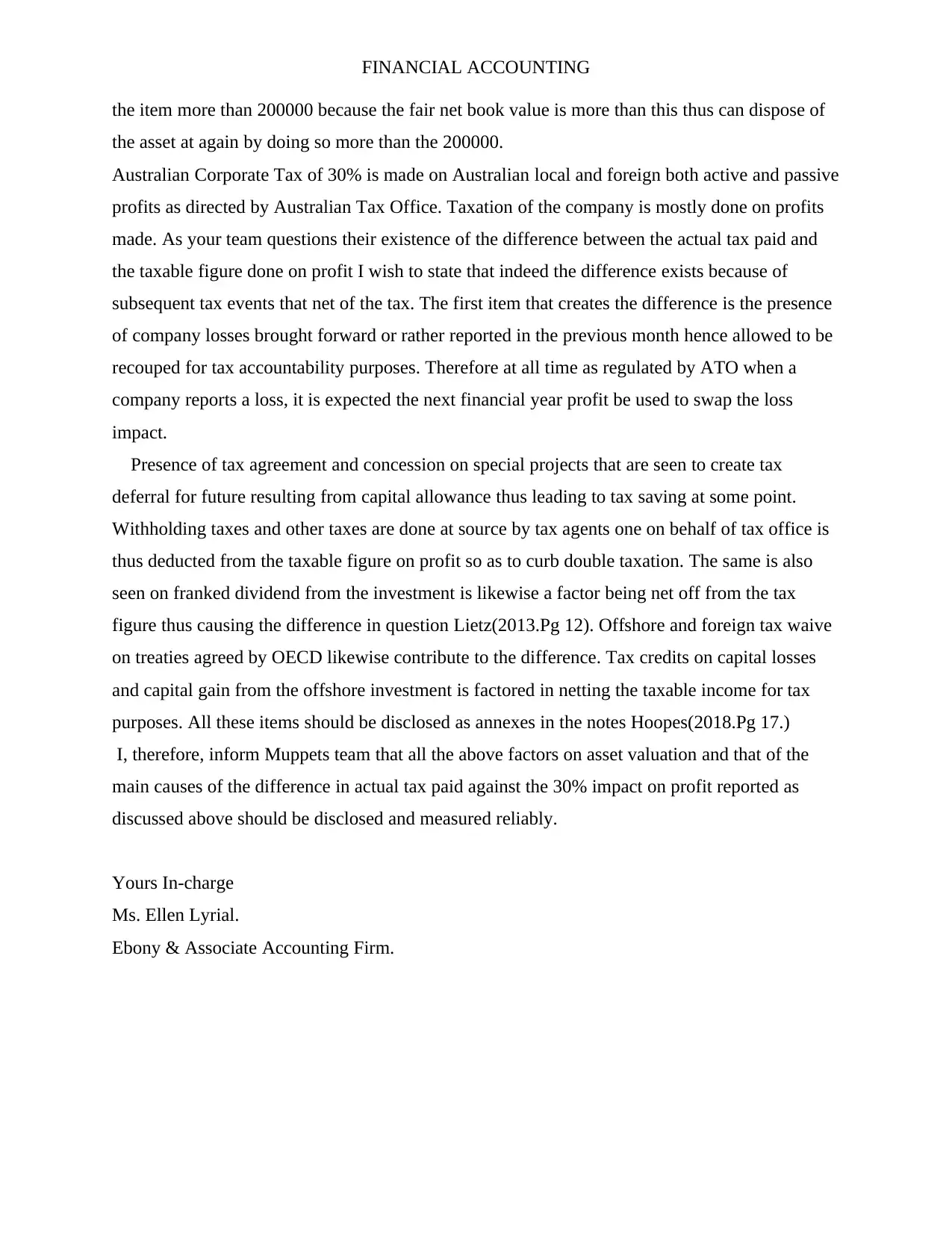
FINANCIAL ACCOUNTING
the item more than 200000 because the fair net book value is more than this thus can dispose of
the asset at again by doing so more than the 200000.
Australian Corporate Tax of 30% is made on Australian local and foreign both active and passive
profits as directed by Australian Tax Office. Taxation of the company is mostly done on profits
made. As your team questions their existence of the difference between the actual tax paid and
the taxable figure done on profit I wish to state that indeed the difference exists because of
subsequent tax events that net of the tax. The first item that creates the difference is the presence
of company losses brought forward or rather reported in the previous month hence allowed to be
recouped for tax accountability purposes. Therefore at all time as regulated by ATO when a
company reports a loss, it is expected the next financial year profit be used to swap the loss
impact.
Presence of tax agreement and concession on special projects that are seen to create tax
deferral for future resulting from capital allowance thus leading to tax saving at some point.
Withholding taxes and other taxes are done at source by tax agents one on behalf of tax office is
thus deducted from the taxable figure on profit so as to curb double taxation. The same is also
seen on franked dividend from the investment is likewise a factor being net off from the tax
figure thus causing the difference in question Lietz(2013.Pg 12). Offshore and foreign tax waive
on treaties agreed by OECD likewise contribute to the difference. Tax credits on capital losses
and capital gain from the offshore investment is factored in netting the taxable income for tax
purposes. All these items should be disclosed as annexes in the notes Hoopes(2018.Pg 17.)
I, therefore, inform Muppets team that all the above factors on asset valuation and that of the
main causes of the difference in actual tax paid against the 30% impact on profit reported as
discussed above should be disclosed and measured reliably.
Yours In-charge
Ms. Ellen Lyrial.
Ebony & Associate Accounting Firm.
the item more than 200000 because the fair net book value is more than this thus can dispose of
the asset at again by doing so more than the 200000.
Australian Corporate Tax of 30% is made on Australian local and foreign both active and passive
profits as directed by Australian Tax Office. Taxation of the company is mostly done on profits
made. As your team questions their existence of the difference between the actual tax paid and
the taxable figure done on profit I wish to state that indeed the difference exists because of
subsequent tax events that net of the tax. The first item that creates the difference is the presence
of company losses brought forward or rather reported in the previous month hence allowed to be
recouped for tax accountability purposes. Therefore at all time as regulated by ATO when a
company reports a loss, it is expected the next financial year profit be used to swap the loss
impact.
Presence of tax agreement and concession on special projects that are seen to create tax
deferral for future resulting from capital allowance thus leading to tax saving at some point.
Withholding taxes and other taxes are done at source by tax agents one on behalf of tax office is
thus deducted from the taxable figure on profit so as to curb double taxation. The same is also
seen on franked dividend from the investment is likewise a factor being net off from the tax
figure thus causing the difference in question Lietz(2013.Pg 12). Offshore and foreign tax waive
on treaties agreed by OECD likewise contribute to the difference. Tax credits on capital losses
and capital gain from the offshore investment is factored in netting the taxable income for tax
purposes. All these items should be disclosed as annexes in the notes Hoopes(2018.Pg 17.)
I, therefore, inform Muppets team that all the above factors on asset valuation and that of the
main causes of the difference in actual tax paid against the 30% impact on profit reported as
discussed above should be disclosed and measured reliably.
Yours In-charge
Ms. Ellen Lyrial.
Ebony & Associate Accounting Firm.
Paraphrase This Document
Need a fresh take? Get an instant paraphrase of this document with our AI Paraphraser
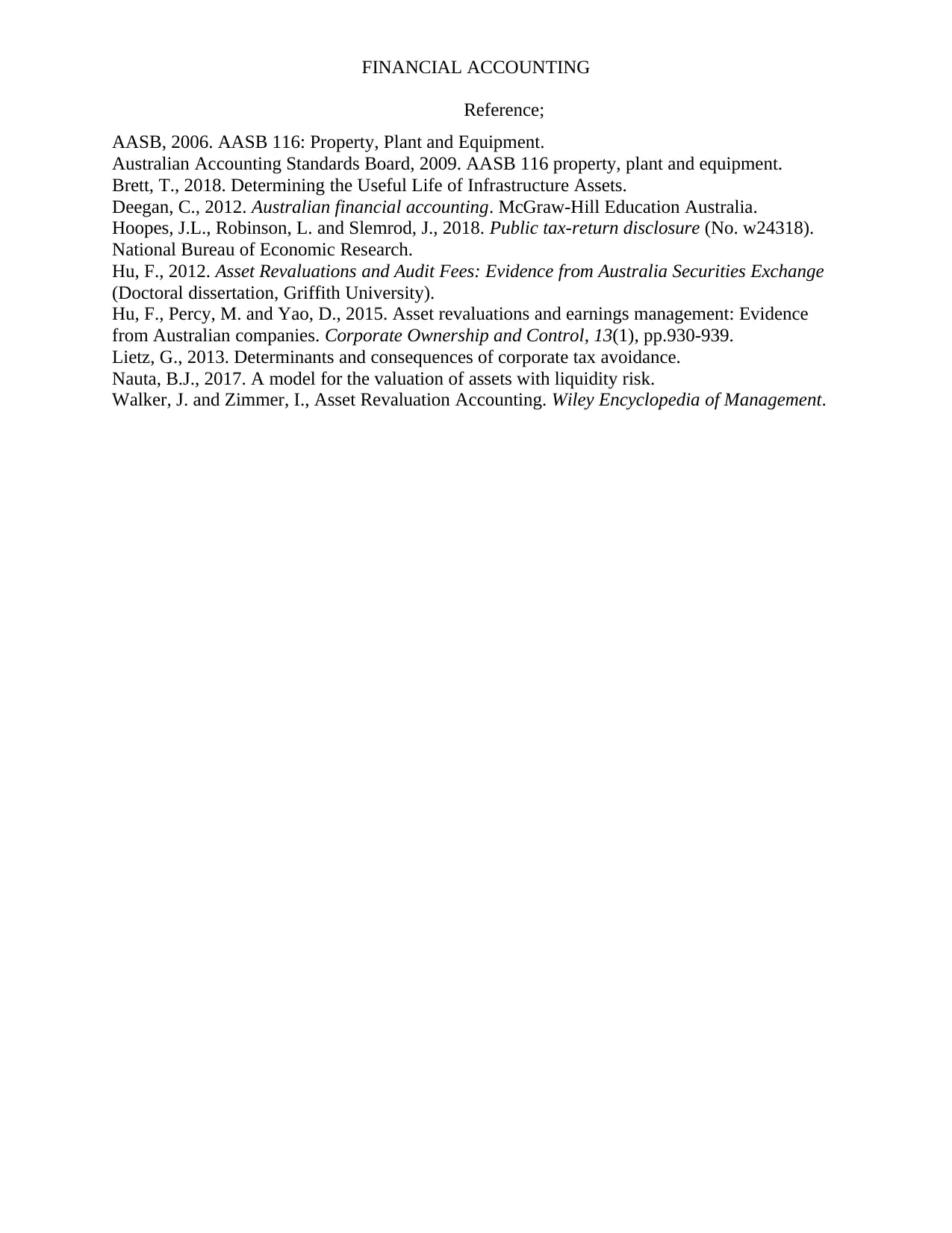
FINANCIAL ACCOUNTING
Reference;
AASB, 2006. AASB 116: Property, Plant and Equipment.
Australian Accounting Standards Board, 2009. AASB 116 property, plant and equipment.
Brett, T., 2018. Determining the Useful Life of Infrastructure Assets.
Deegan, C., 2012. Australian financial accounting. McGraw-Hill Education Australia.
Hoopes, J.L., Robinson, L. and Slemrod, J., 2018. Public tax-return disclosure (No. w24318).
National Bureau of Economic Research.
Hu, F., 2012. Asset Revaluations and Audit Fees: Evidence from Australia Securities Exchange
(Doctoral dissertation, Griffith University).
Hu, F., Percy, M. and Yao, D., 2015. Asset revaluations and earnings management: Evidence
from Australian companies. Corporate Ownership and Control, 13(1), pp.930-939.
Lietz, G., 2013. Determinants and consequences of corporate tax avoidance.
Nauta, B.J., 2017. A model for the valuation of assets with liquidity risk.
Walker, J. and Zimmer, I., Asset Revaluation Accounting. Wiley Encyclopedia of Management.
Reference;
AASB, 2006. AASB 116: Property, Plant and Equipment.
Australian Accounting Standards Board, 2009. AASB 116 property, plant and equipment.
Brett, T., 2018. Determining the Useful Life of Infrastructure Assets.
Deegan, C., 2012. Australian financial accounting. McGraw-Hill Education Australia.
Hoopes, J.L., Robinson, L. and Slemrod, J., 2018. Public tax-return disclosure (No. w24318).
National Bureau of Economic Research.
Hu, F., 2012. Asset Revaluations and Audit Fees: Evidence from Australia Securities Exchange
(Doctoral dissertation, Griffith University).
Hu, F., Percy, M. and Yao, D., 2015. Asset revaluations and earnings management: Evidence
from Australian companies. Corporate Ownership and Control, 13(1), pp.930-939.
Lietz, G., 2013. Determinants and consequences of corporate tax avoidance.
Nauta, B.J., 2017. A model for the valuation of assets with liquidity risk.
Walker, J. and Zimmer, I., Asset Revaluation Accounting. Wiley Encyclopedia of Management.
1 out of 5
Related Documents
Your All-in-One AI-Powered Toolkit for Academic Success.
+13062052269
info@desklib.com
Available 24*7 on WhatsApp / Email
![[object Object]](/_next/static/media/star-bottom.7253800d.svg)
Unlock your academic potential
Copyright © 2020–2025 A2Z Services. All Rights Reserved. Developed and managed by ZUCOL.


